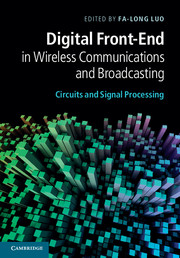Book contents
- Frontmatter
- Contents
- Contributors
- Preface
- Part I Introduction to digital front-end
- 1 Introduction to wireless communications and digital broadcasting
- 2 Basic principles and protocols of digital wireless communications
- 3 Digital front-end and system overview in wireless communication
- 4 System overview and front-end technologies in digital broadcasting
- 5 Digital front-end for multiple standards and multimode compatibility
- Part II DPD and CFR
- Part III DUC, DDC, ADC, DAC, and NCO
- Part IV Digital calibration, imbalance compensation, and error corrections
- Part V Circuits and system integration in digital front-end
- Index
- References
2 - Basic principles and protocols of digital wireless communications
from Part I - Introduction to digital front-end
Published online by Cambridge University Press: 07 October 2011
- Frontmatter
- Contents
- Contributors
- Preface
- Part I Introduction to digital front-end
- 1 Introduction to wireless communications and digital broadcasting
- 2 Basic principles and protocols of digital wireless communications
- 3 Digital front-end and system overview in wireless communication
- 4 System overview and front-end technologies in digital broadcasting
- 5 Digital front-end for multiple standards and multimode compatibility
- Part II DPD and CFR
- Part III DUC, DDC, ADC, DAC, and NCO
- Part IV Digital calibration, imbalance compensation, and error corrections
- Part V Circuits and system integration in digital front-end
- Index
- References
Summary
Introduction
Recent advantages in wireless communications have enabled reliable long-range coupling, high data rate services at mobile users and support of multimedia content. The vast majority of currently operating wireless networks is based on digital processing at both transmission ends, where incoming analog signals (e.g. voice) are converted into digital bit streams. Digital transmission offers increased reliability and flexibility when compared to analog transmission, as well as compatibility among different digital systems. The boost in wireless digital communications came along with the development of small-scale integrated circuits, that made feasible the deployment of cost-effective and time-efficient implementations of complex operations related with digital processing (e.g. sampling, quantization, matrix inversion, fast Fourier transform, etc.). However, the performance of a wireless network depends not only on the installed hardware at both transmission ends but on a number of issues related to system protocols and architecture, such as transceiver signal processing techniques and resource management strategies. The main challenging task in the design of a wireless link is the provision of acceptable quality of service at fixed or mobile users, despite the channel conditions. The latter term refers to channel variations either due to multipath propagation or due to pathloss. Moreover, in wireless networks different users share the same physical access medium; hence another challenging task is the implementation of effective physical layer protocols that allow the simultaneous transmission and reception from different users as well as the maximization of per user capacity.
In 1998, the Wideband Code Division Multiple Access (WCDMA) physical layer protocol was adopted for third-generation (3G) mobile networks, which offer higher data rates and multimedia communications when compared to second-generation mobile networks. However, as the demand for even higher data rates is constantly increasing, the research on spectrum efficient physical layer architectures continues to be important. In April of 2009, the Orthogonal Frequency Division Multiple Access (OFDMA) physical layer protocol was proposed for the Long Term Evolution (LTE) of the currently operating 3G networks. Fourth-generation (4G) wireless networks will be in position to provide among other features peak data rates up to 300 Mb/s and a radio-network delay less than 5 ms.
- Type
- Chapter
- Information
- Digital Front-End in Wireless Communications and BroadcastingCircuits and Signal Processing, pp. 28 - 49Publisher: Cambridge University PressPrint publication year: 2011



